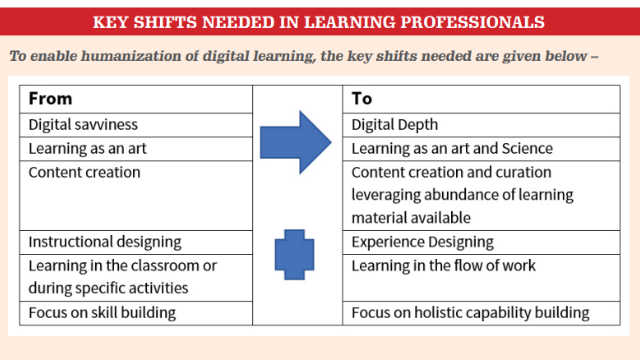Humanising digital learning

Learning & Development
161 week ago — 6 min read
The the world is getting more and more digital and learning is no exception. In fact, Learning & Development (L&D) pioneered digital adoption at the start of the century by introducing Learning Management Systems and web-based modules.
As digital learning becomes the way of life, it is essential that we focus on Learner Experience which is an important ingredient to ensure effectiveness. The knowledge imparted should resonate with the learners, and hence humanising digital learning becomes important.
The following factors are important for humanising digital learning
1. Understanding the customer
2. Strengthening focus
3. Delivering experience
4. Remembering the fundamentals
A sharp focus on each one of them will ensure that we are delivering a powerful learning experience.
Understanding the customer
As L&D professionals, we need to don the design thinking hat and understand the customer—our learners. This would mean the following:
- Understanding the different learner personas within the ecosystem. The personas can be based upon different demographic factors or any other differentiating element. This would ensure that we are able to customise our offerings based upon needs.
- Taking consistent efforts to engage with learners to better understand them and their learning preferences.
- Having clarity on learner behaviours like what they are learning on different platforms, what formats they are using, what are their learning likes and dislikes, what challenges are they facing and more
Undertaking all of the above will leave one with abundance of insights on learners, which is an important element of humanising learning.

Strengthening focus
This requires the learning team to sharpen its focus on technology. The following can aid with the same:
- Deepening one’s understanding of current and emerging technologies in the world of learning
- Understanding the technology stack in one’s own organisation and what purpose it is serving: Are they differentiated and meeting the intended outcomes?
- Understanding the organisation’s digital technology roadmap: What is the learning tech maturity at this point and how would they want to see it evolve?
- Understanding the differentiated metrics and outcomes for different initiatives as some of the traditional metrics may not hold good for certain digital initiatives
Delivering experience
It is important to remember that we are delivering an experience, which should be both enjoyable and powerful. Keeping in mind the following aspects will ensure the same:
- The experience should be both seamless and intuitive so that learner engagement is high. This will ensure learners come back without any resistance.
- The learning should be personalised, which can be achieved by leveraging available technology. When the learner realises that the learning is ‘just for me’, it answers the question ‘what is in it for me’. This ensures that the learning is aligned to the needs of the learner.
- Pushing learning hampers experience. Instead, the focus should be on creating a pull. This can be achieved by engaging multiple levers like managers and peers.
- Celebrating learners and learning can go a long a way in bringing that human touch to digital content. Gamifying learning with recognition at different milestones is important.
Remembering fundamentals
The fundamentals of learning hold good in the digital context as well. The key pieces that one should not lose sight off are:
- Whatever be the digital mode of delivery, content and context matter. This means having robust content that is customized to suit the organisational context.
- Design skills are important and instructional design should expand to include experience design and design thinking.
- Digital should focus on the 70:20:10 of learning; relevant technologies to support the 70 and the 20 should be put in place.
- Building Learning to Learn skills in employees is critical so that they can appreciate and pull the digital learning.
Digital learning is an opportunity to build capabilities with speed, which is the need of the hour. Focus on humanising will ensure that we achieve this objective effectively and successfully.
Also read: The Learning & Development imperative
Image source: Canva
Article & inforgraphic source: STOrai Magazine. Authored by Hemalakshmi Raju, who is the Chief Learning Officer (Hydrocarbon Business), Reliance Industries Ltd. She is a Learning & Leadership Development expert with a strong passion to create an impact on individuals and organizations. She holds multi-sector experience and has worked with large business conglomerates including Reliance Industries, Tata Motors & Cipla.
Disclaimer: The views and opinions expressed in this article are those of the author and do not necessarily reflect the views, official policy or position of GlobalLinker.
View STOrai 's profile
Other articles written by STOrai Magazine
The Art & Science of People Pleasing in Retail
14 week ago
Enhanced Brand Storytelling in the Digital Age
46 week ago
Most read this week













Comments
Share this content
Please login or Register to join the discussion